what term refers to an opening through a structure?
Standard anatomical terms of location are used to unambiguously depict the anatomy of animals, including humans. The terms, typically derived from Latin or Greek roots, draw something in its standard anatomical position. This position provides a definition of what is at the front end ("inductive"), behind ("posterior") and and then on. As part of defining and describing terms, the body is described through the use of anatomical planes and anatomical axes.
The meaning of terms that are used tin can change depending on whether an organism is bipedal or quadrupedal. Additionally, for some animals such as invertebrates, some terms may non have whatever meaning at all; for example, an animal that is radially symmetrical will have no inductive surface, but can even so take a clarification that a office is shut to the middle ("proximal") or further from the centre ("distal").
International organisations have determined vocabularies that are often used equally standard vocabularies for subdisciplines of beefcake, for example, Terminologia Anatomica for humans, and Nomina Anatomica Veterinaria for animals. These allow parties that utilise anatomical terms, such as anatomists, veterinarians, and medical doctors to accept a standard set of terms to communicate clearly the position of a construction.
Introduction [edit]

Because of differences in the way humans and other animals are structured, different terms are used according to the neuraxis and whether an creature is a vertebrate or invertebrate.
Standard anatomical and zoological terms of location take been adult, usually based on Latin and Greek words, to enable all biological and medical scientists, veterinarians, doctors and anatomists to precisely delineate and communicate data about beast bodies and their organs, even though the meaning of some of the terms often is context-sensitive.[one] [two] Much of this information has been standardised in internationally agreed vocabularies for humans (Terminologia Anatomica)[2] and animals (Nomina Anatomica Veterinaria).[1]
For humans, one blazon of vertebrate, and other animals that stand up on two feet (bipeds), terms that are used are different from those that stand on four (quadrupeds).[1] One reason is that humans have a dissimilar neuraxis and some other is that different animals that rest on four limbs, humans are considered when describing anatomy every bit being in the standard anatomical position, which is continuing up with arms outstretched.[2] Thus, what is on "top" of a human being is the head, whereas the "top" of a dog may be its back, and the "top" of a flounder could refer to either its left or its right side. Unique terms are used to describe animals without a backbone (invertebrates), because of their wide diversity of shapes and symmetry.[3]
Standard anatomical position [edit]

Because animals can alter orientation with respect to their environment, and because appendages like limbs and tentacles can change position with respect to the master body, terms to draw position need to refer to an animal when information technology is in its standard anatomical position.[1] This ways descriptions every bit if the organism is in its standard anatomical position, even when the organism in question has appendages in another position. This helps avert confusion in terminology when referring to the same organism in dissimilar postures.[1] In humans, this refers to the trunk in a continuing position with arms at the side and palms facing forward, with thumbs out and to the sides.[2] [one]
Combined terms [edit]
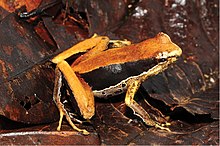
Many anatomical terms tin can be combined, either to indicate a position in ii axes simultaneously or to indicate the management of a movement relative to the body. For example, "anterolateral" indicates a position that is both anterior and lateral to the body axis (such as the bulk of the pectoralis major musculus).
In radiology, an X-ray epitome may be said to exist "anteroposterior", indicating that the beam of X-rays passes from their source to patient's inductive body wall through the trunk to exit through posterior body wall.[four] Combined terms were once generally, hyphenated, but the modernistic tendency is to omit the hyphen.[5]
Planes [edit]

Anatomical planes in a human being
Anatomical terms depict structures with relation to four master anatomical planes:[2]
- The median plane, which divides the torso into left and right.[2] [6] This passes through the head, spinal string, navel, and, in many animals, the tail.[6]
- The sagittal planes, which are parallel to the median plane.[1]
- The frontal plane, likewise chosen the coronal plane, which divides the body into front end and back.[2]
- The horizontal plane, too known as the transverse plane, which is perpendicular to the other 2 planes.[ii] In a man, this aeroplane is parallel to the ground; in a quadruped, this divides the fauna into anterior and posterior sections.[3]
Axes [edit]
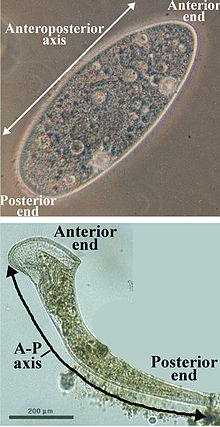
Organisms where the ends of the long centrality are singled-out. (Paramecium caudatum, above, and Stentor roeselii, below.)
The axes of the body are lines drawn nigh which an organism is roughly symmetrical.[seven] To practice this, distinct ends of an organism are called, and the axis is named co-ordinate to those directions. An organism that is symmetrical on both sides has 3 main axes that intersect at right angles.[three] An organism that is round or non symmetrical may have different axes.[3] Instance axes are:
- The anteroposterior centrality[8]
- The cephalocaudal axis[9]
- The dorsoventral axis[10]
Examples of axes in specific animals are shown below.
-
Anatomical axes and directions in a fish
-
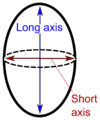
Spheroid or near-spheroid organs such every bit testes may exist measured by "long" and "short" axis.[11]
Modifiers [edit]

Terms can be modified with prefixes and suffixes. In this image showing the jellyfish species Chrysaora, the prefix 'ab-', is used to bespeak something that is 'away from' the mouth, for example the aboral. Other terms are combined to bespeak axes, such as proximodistal axis.
Several terms are unremarkably seen and used as prefixes:
- Sub- (from Latin sub 'preposition beneath, close to, almost etc') is used to indicate something that is beneath, or something that is subordinate to or bottom than.[12] For example, subcutaneous ways beneath the skin, and "subglobular" may hateful smaller than a globule
- Hypo- (from Aboriginal Greek ὑπό 'under') is used to indicate something that is beneath.[xiii] For example, the hypoglossal nerve supplies the muscles below the tongue.
- Infra- (from Latin infra 'under') is used to signal something that is within or beneath.[14] For instance, the infraorbital nerve runs within the orbit.
- Inter- (from Latin inter 'between') is used to point something that is between.[15] For example, the intercostal muscles run between the ribs.
- Super- or Supra- (from Latin super, supra 'to a higher place, on top of') is used to indicate something that is above something else.[xvi] For case, the supraorbital ridges are in a higher place the eyes.
Other terms are used as suffixes, added to the end of words:
- -advertizing (from Latin advertisement 'towards') and ab- (from Latin ab) are used to indicate that something is towards (-ad) or away from (-ab) something else.[17] [xviii] For example, "distad" means "in the distal direction", and "distad of the femur" means "across the femur in the distal direction". Further examples may include cephalad (towards the cephalic cease), craniad, and proximad.[19]
Master terms [edit]
Superior and inferior [edit]
Superior (from Latin super 'above') describes what is higher up something[20] and inferior (from Latin inferus 'below') describes what is below information technology.[21] For example, in the anatomical position, the most superior part of the human trunk is the head and the almost inferior is the anxiety. Every bit a 2nd case, in humans, the neck is superior to the chest only junior to the head.
Anterior and posterior [edit]
Anterior (from Latin dues 'before') describes what is in front,[22] and posterior (from Latin post 'afterwards') describes what is to the back of something.[23] For example, for a dog the nose is anterior to the eyes and the tail is considered the about posterior part; for many fish the gill openings are posterior to the optics but anterior to the tail.
Medial and lateral [edit]
These terms describe how close something is to the midline, or the medial aeroplane.[2] Lateral (from Latin lateralis 'to the side') describes something to the sides of an beast, as in "left lateral" and "right lateral". Medial (from Latin medius 'centre') describes structures close to the midline,[2] or closer to the midline than another structure. For example, in a human, the arms are lateral to the torso. The genitals are medial to the legs.
The terms "left" and "correct" are sometimes used, or their Latin alternatives (Latin: dexter, lit.'right'; Latin: sinister, lit.'left'). However, as left and right sides are mirror images, using these words is somewhat disruptive, as structures are duplicated on both sides. For instance, it is very confusing to say the dorsal fin of a fish is "right of" the left pectoral fin, simply is "left of" the right centre,[ dubious ] but much easier and clearer to say "the dorsal fin is medial to the pectoral fins".
Terms derived from lateral include:
- Contralateral (from Latin contra 'confronting'): on the side opposite to another construction.[24] For example, the right arm and leg are controlled by the left, contralateral, side of the brain.
- Ipsilateral (from Latin ipse 'same'): on the same side as another construction.[25] For example, the left arm is ipsilateral to the left leg.
- Bilateral (from Latin bis 'twice'): on both sides of the body.[26] For instance, bilateral orchiectomy means removal of testes on both sides of the body.
- Unilateral (from Latin unus 'one'): on one side of the body.[27] For example, a stroke can outcome in unilateral weakness, meaning weakness on one side of the trunk.
Varus (from Latin 'knock-kneed') and valgus (from Latin 'bow-legged') are terms used to draw a state in which a part further away is abnormally placed towards (varus) or abroad from (valgus) the midline.[28]
Proximal and distal [edit]
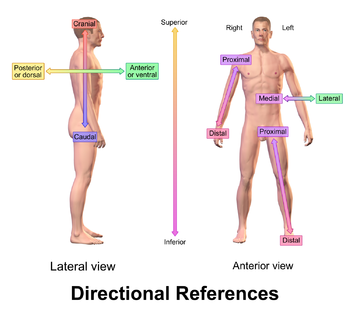
Anatomical directional reference
The terms proximal (from Latin proximus 'nearest') and distal (from Latin distare 'to stand away from') are used to describe parts of a feature that are close to or distant from the main mass of the body, respectively.[29] Thus the upper arm in humans is proximal and the manus is distal.
"Proximal and distal" are oft used when describing appendages, such as fins, tentacles, and limbs. Although the direction indicated by "proximal" and "distal" is always respectively towards or abroad from the signal of attachment, a given structure tin be either proximal or distal in relation to some other point of reference. Thus the elbow is distal to a wound on the upper arm, but proximal to a wound on the lower arm.[thirty]
This terminology is also employed in molecular biology and therefore by extension is as well used in chemical science, specifically referring to the diminutive loci of molecules from the overall moiety of a given compound.[31]
Central and peripheral [edit]
Central and peripheral refer to the distance towards and away from the center of something.[32] That might be an organ, a region in the body, or an anatomical structure. For instance, the Fundamental nervous system and the peripheral nervous systems.
Cardinal (from Latin centralis) describes something close to the centre.[32] For example, the bully vessels run centrally through the body; many smaller vessels branch from these.
Peripheral (from Latin peripheria, originally from Ancient Greek) describes something further away from the centre of something.[33] For example, the arm is peripheral to the trunk.
Superficial and deep [edit]
These terms refer to the distance of a construction from the surface.[2]
Deep (from Old English) describes something further away from the surface of the organism.[34] For example, the external oblique musculus of the belly is deep to the skin. "Deep" is one of the few anatomical terms of location derived from Old English language rather than Latin – the anglicised Latin term would have been "profound" (from Latin profundus 'due to depth').[ane] [35]
Superficial (from Latin superficies 'surface') describes something virtually the outer surface of the organism.[1] [36] For example, in skin, the epidermis is superficial to the subcutis.
Dorsal and ventral [edit]
These 2 terms, used in anatomy and embryology, describe something at the dorsum (dorsal) or front/abdomen (ventral) of an organism.[two]
The dorsal (from Latin back 'back') surface of an organism refers to the back, or upper side, of an organism. If talking about the skull, the dorsal side is the top.[37]
The ventral (from Latin venter 'belly') surface refers to the front, or lower side, of an organism.[37]
For example, in a fish, the pectoral fins are dorsal to the anal fin, but ventral to the dorsal fin.
Cranial and caudal [edit]

In the human skull, the terms rostral and caudal are adapted to the curved neuraxis of Hominidae, rostrocaudal significant the region on C shape connecting rostral and caudal regions.
Specific terms exist to draw how close or far something is to the head or tail of an animate being. To draw how close to the head of an animal something is, three distinct terms are used:
- Rostral (from Latin rostrum 'beak, nose') describes something situated toward the oral or nasal region, or in the example of the brain, toward the tip of the frontal lobe.[38]
- Cranial (from Greek κρανίον 'skull') or cephalic (from Greek κεφαλή 'head') describes how close something is to the head of an organism.[39]
- Caudal (from Latin cauda 'tail') describes how close something is to the trailing end of an organism.[xl]
For case, in horses, the optics are caudal to the nose and rostral to the back of the head.
These terms are generally preferred in veterinary medicine and non used as frequently in human medicine.[41] [42] [43] In humans, "cranial" and "cephalic" are used to refer to the skull, with "cranial" existence used more commonly. The term "rostral" is rarely used in man anatomy, apart from embryology, and refers more than to the front of the confront than the superior aspect of the organism. Similarly, the term "caudal" is used more than in embryology and only occasionally used in human being beefcake.[ii] This is because the encephalon is situated at the superior part of the head whereas the nose is situated in the anterior part. Thus, the "rostrocaudal axis" refers to a C shape (come across epitome).
Other terms and special cases [edit]
Anatomical landmarks [edit]
The location of anatomical structures can also be described in relation to unlike anatomical landmarks. They are used in anatomy, surface beefcake, surgery, and radiology.[44]
Structures may be described as beingness at the level of a specific spinal vertebra, depending on the section of the vertebral column the structure is at.[44] The position is often abbreviated. For example, structures at the level of the quaternary cervical vertebra may be abbreviated every bit "C4", at the level of the fourth thoracic vertebra "T4", and at the level of the third lumbar vertebra "L3". Because the sacrum and coccyx are fused, they are not often used to provide the location.
References may too accept origin from superficial beefcake, made to landmarks that are on the skin or visible underneath.[44] For example, structures may be described relative to the anterior superior iliac spine, the medial malleolus or the medial epicondyle.
Anatomical lines are used to depict anatomical location. For example, the mid-clavicular line is used every bit role of the cardiac exam in medicine to feel the apex shell of the centre.
Mouth and teeth [edit]
Special terms are used to draw the rima oris and teeth.[2] Fields such equally osteology, palaeontology and dentistry apply special terms of location to depict the rima oris and teeth. This is because although teeth may be aligned with their primary axes within the jaw, some different relationships crave special terminology as well; for example, teeth also can be rotated, and in such contexts terms like "anterior" or "lateral" become ambiguous.[45] [46] For instance, the terms "distal" and "proximal" are too redefined to mean the altitude abroad or close to the dental arch, and "medial" and "lateral" are used to refer to the closeness to the midline of the dental arch.[47] Terms used to depict structures include "buccal" (from Latin bucca 'cheek') and "palatal" (from Latin) referring to structures close to the cheek and hard palate respectively.[47]
Hands and feet [edit]
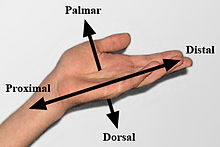
Anatomical terms used to describe a human being mitt
Several anatomical terms are detail to the easily and feet.[2]
Additional terms may be used to avert confusion when describing the surfaces of the hand and what is the "anterior" or "posterior" surface – . The term "anterior", while anatomically right, can be confusing when describing the palm of the mitt; Similarly is "posterior", used to describe the back of the hand and arm. This defoliation tin can ascend because the forearm tin can pronate and supinate and flip the location of the hand. For improved clarity, the directional term palmar (from Latin palma 'palm of the paw') is normally used to describe the front of the hand, and dorsal is the dorsum of the hand. For example, the top of a domestic dog'south paw is its dorsal surface; the underside, either the palmar (on the forelimb) or the plantar (on the hindlimb) surface. The palmar fascia is palmar to the tendons of muscles which flex the fingers, and the dorsal venous arch is so named considering it is on the dorsal side of the foot.
In humans, volar tin likewise be used synonymously with palmar to refer to the underside of the palm, but plantar is used exclusively to draw the sole. These terms describe location every bit palmar and plantar; For example, volar pads are those on the underside of hands or fingers; the plantar surface describes the sole of the heel, pes or toes.
Similarly, in the forearm, for clarity, the sides are named afterward the basic. Structures closer to the radius are radial, structures closer to the ulna are ulnar, and structures relating to both bones are referred to as radioulnar. Similarly, in the lower leg, structures near the tibia (shinbone) are tibial and structures near the fibula are fibular (or peroneal).
Rotational direction [edit]
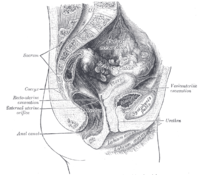

Anteversion and retroversion are complementary terms describing an anatomical construction that is rotated forwards (towards the front end of the body) or backwards (towards the dorsum of the torso), relative to some other position. They are particularly used to draw the curvature of the uterus.[48] [49]
- Anteversion (from Latin anteversus) describes an anatomical construction being tilted further forward than normal, whether pathologically or incidentally.[48] For example, a adult female's uterus typically is anteverted, tilted slightly forward. A misaligned pelvis may exist anteverted, that is to say tilted forrard to some relevant caste.
- Retroversion (from Latin retroversus) describes an anatomical structure tilted back abroad from something.[49] An example is a retroverted uterus.[49]
Other directional terms [edit]
Several other terms are also used to draw location. These terms are not used to course the fixed axes. Terms include:
- Axial (from Latin axis 'axle'): around the central centrality of the organism or the extremity. Two related terms, "abaxial" and "adaxial", refer to locations away from and toward the central axis of an organism, respectively
- Luminal (from Latin lumen 'calorie-free, opening'): on the—hollow—inside of an organ's lumen (body cavity or tubular construction);[50] [51] adluminal is towards, abluminal is away from the lumen.[52] Opposite to outermost (the adventitia, serosa, or the cavity's wall).[53]
- Parietal (from Latin paries 'wall'): pertaining to the wall of a torso cavity.[54] For case, the parietal peritoneum is the lining on the inside of the abdominal crenel. Parietal can also refer specifically to the parietal bone of the skull or associated structures.
- Terminal (from Latin terminus 'boundary or end') at the extremity of a unremarkably projecting structure.[55] For example, "...an antenna with a terminal sensory hair".
- Visceral and viscus (from Latin viscera 'internal organs'): associated with organs within the body's cavities.[56] For example, the tum is covered with a lining chosen the visceral peritoneum as opposed to the parietal peritoneum. Viscus can also be used to mean "organ".[56] For example, the stomach is a viscus inside the abdominal crenel, and visceral pain refers to pain originating from internal organs.
- Aboral (opposite to oral) is used to announce a location along the gastrointestinal canal that is relatively closer to the anus.[57]
Specific animals and other organisms [edit]
Different terms are used because of different body plans in animals, whether animals stand on 1 or two legs, and whether an animal is symmetrical or not, as discussed higher up. For example, as humans are approximately bilaterally symmetrical organisms, anatomical descriptions commonly utilise the aforementioned terms as those for other vertebrates.[58] Nonetheless, humans stand upright on two legs, meaning their anterior/posterior and ventral/dorsal directions are the same, and the inferior/superior directions are necessary.[59] Humans do not have a bill, so a term such every bit "rostral" used to refer to the beak in some animals is instead used to refer to part of the brain;[60] humans do as well non have a tail so a term such as "caudal" that refers to the tail end may too be used in humans and animals without tails to refer to the hind part of the torso.[61]
In invertebrates, the large variety of torso shapes presents a hard problem when attempting to apply standard directional terms. Depending on the organism, some terms are taken by analogy from vertebrate anatomy, and appropriate novel terms are applied as needed. Some such borrowed terms are widely applicable in most invertebrates; for example proximal, pregnant "nearly" refers to the part of an appendage nearest to where it joins the body, and distal, meaning "standing away from" is used for the part furthest from the betoken of attachment. In all cases, the usage of terms is dependent on the torso program of the organism.
-

Anatomical terms of location in a dog
-

Anatomical terms of location in a kangaroo
-
Anatomical terms of location in a fish.
-
Anatomical terms of location in a equus caballus.
Asymmetrical and spherical organisms [edit]

Asymmetrical and spherical body shapes. (a) An organism with an asymmetrical, amoeboid, body plan (Amoeba proteus – an amoeba). (b) An organism with a spherical body program (Actinophrys sol – a heliozoan).
In organisms with a child-bearing shape, such equally amoeboid organisms, nigh directional terms are meaningless, since the shape of the organism is not constant and no distinct axes are fixed. Similarly, in spherically symmetrical organisms, there is nothing to distinguish ane line through the centre of the organism from any other. An indefinite number of triads of mutually perpendicular axes could be defined, simply any such choice of axes would exist useless, as nil would distinguish a called triad from whatever others. In such organisms, just terms such as superficial and deep, or sometimes proximal and distal, are usefully descriptive.

Four individuals of Phaeodactylum tricornutum, a diatom with a fixed elongated shape.
Elongated organisms [edit]
In organisms that maintain a constant shape and have 1 dimension longer than the other, at to the lowest degree two directional terms tin exist used. The long or longitudinal axis is defined by points at the opposite ends of the organism. Similarly, a perpendicular transverse axis tin be defined by points on opposite sides of the organism. There is typically no footing for the definition of a third axis. Usually such organisms are planktonic (gratuitous-swimming) protists, and are near always viewed on microscope slides, where they appear essentially two-dimensional. In some cases a 3rd axis can be defined, particularly where a not-concluding cytostome or other unique structure is present.[43]
Some elongated protists take distinctive ends of the body. In such organisms, the end with a mouth (or equivalent structure, such every bit the cytostome in Paramecium or Stentor), or the cease that usually points in the management of the organism'south locomotion (such as the stop with the flagellum in Euglena), is commonly designated as the anterior end. The contrary cease so becomes the posterior terminate.[43] Properly, this terminology would apply just to an organism that is always planktonic (not normally attached to a surface), although the term tin also be applied to ane that is sessile (normally fastened to a surface).[62]

Organisms that are fastened to a substrate, such as sponges, creature-like protists also take distinctive ends. The part of the organism attached to the substrate is normally referred to as the basal end (from Latin basis 'support/foundation'), whereas the stop furthest from the attachment is referred to equally the apical end (from Latin apex 'acme/tip').
Radially symmetrical organisms [edit]
Radially symmetrical organisms include those in the group Radiata – primarily jellyfish, sea anemones and corals and the comb jellies.[41] [43] Adult echinoderms, such as starfish, ocean urchins, sea cucumbers and others are also included, since they are pentaradial, meaning they have five discrete rotational symmetry. Echinoderm larvae are not included, since they are bilaterally symmetrical.[41] [43] Radially symmetrical organisms ever take i distinctive axis.
Cnidarians (jellyfish, bounding main anemones and corals) have an incomplete digestive organization, meaning that one end of the organism has a oral cavity, and the reverse finish has no opening from the gut (coelenteron).[43] For this reason, the end of the organism with the oral cavity is referred to as the oral cease (from Latin ōrālis 'of the oral fissure'),[63] and the opposite surface is the aboral finish (from Latin ab- 'away from').[64]
Different vertebrates, cnidarians have no other distinctive axes. "Lateral", "dorsal", and "ventral" have no significant in such organisms, and all can be replaced past the generic term peripheral (from Aboriginal Greek περιφέρεια 'circumference'). Medial tin can be used, simply in the case of radiates indicates the central indicate, rather than a central centrality as in vertebrates. Thus, in that location are multiple possible radial axes and medio-peripheral (half-) axes. Yet, some biradially symmetrical comb jellies do have distinct "tentacular" and "pharyngeal" axes[65] and are thus anatomically equivalent to bilaterally symmetrical animals.
-
Aurelia aurita, another species of jellyfish, showing multiple radial and medio-peripheral axes
-

The ocean star Porania pulvillus, aboral and oral surfaces
Spiders [edit]
Special terms are used for spiders. Ii specialized terms are useful in describing views of arachnid legs and pedipalps. Prolateral refers to the surface of a leg that is closest to the anterior end of an arachnid'south torso. Retrolateral refers to the surface of a leg that is closest to the posterior end of an arachnid's body.[66] About spiders accept eight eyes in 4 pairs. All the eyes are on the carapace of the prosoma, and their sizes, shapes and locations are characteristic of various spider families and other taxa.[67] Usually, the eyes are arranged in ii roughly parallel, horizontal and symmetrical rows of eyes.[67] Eyes are labelled according to their position equally inductive and posterior lateral eyes (ALE) and (PLE); and anterior and posterior median optics (AME) and (PME).[67]
-
Aspects of spider anatomy; This aspect shows the mainly prolateral surface of the anterior femora, plus the typical horizontal eye pattern of the Sparassidae
-

Typical arrangement of eyes in the Lycosidae, with PME being the largest
Run into also [edit]
- Geometric terms of location
- Handedness
- Laterality
- Proper correct and proper left
- Reflection symmetry
- Sinistral and dextral
References [edit]
- ^ a b c d e f thousand h i Dyce, Sack & Wensing 2010, pp. ii–3.
- ^ a b c d e f thou h i j chiliad l yard n o Grayness'south Anatomy 2016, pp. xvi–xvii.
- ^ a b c d Kardong'south 2019, p. 16.
- ^ Hofer, Matthias (2006). The Chest Ten-ray: A Systematic Pedagogy Atlas. Thieme. p. 24. ISBN978-iii-13-144211-half-dozen.
- ^ "dorsolateral". Merriam-Webster.
- ^ a b Wake 1992, p. 6.
- ^ Collins 2020, "axis", accessed 17 July 2020.
- ^ Merriam-Webster 2020, "Anteroposterior", accessed 14 October 2020.
- ^ Merriam-Webster 2020, "Cephalocaudal", accessed 14 October 2020.
- ^ Merriam-Webster 2020, "Dorsoventral", accessed 14 Oct 2020.
- ^ Pellerito, John; Polak, Joseph F. (2012). Introduction to Vascular Ultrasonography (6th ed.). Elsevier Health Sciences. p. 559. ISBN978-1-4557-3766-6.
- ^ Merriam-Webster 2020, "Sub-", accessed on three July 2020.
- ^ Merriam-Webster 2020, "Hypo-", accessed on three July 2020.
- ^ Merriam-Webster 2020, "Infra-", accessed on iii July 2020.
- ^ Merriam-Webster 2020, "Inter-", accessed on iii July 2020.
- ^ Merriam-Webster 2020, "Super-" and "Supra-", accessed on 3 July 2020.
- ^ Merriam-Webster 2020, "-ad", accessed on three July 2020.
- ^ Merriam-Webster 2020, "an-", accessed on 17 July 2020.
- ^ Gordh, Gordon; Headrick, David H (2011). A Dictionary of Entomology (2nd ed.). CABI. ISBN978-1845935429.
- ^ Collins 2020, "superior", accessed 2 July 2020.
- ^ Collins 2020, "inferior", accessed 2 July 2020.
- ^ Collins 2020, "anterior", accessed 2 July 2020.
- ^ Collins 2020, "posterior", accessed two July 2020.
- ^ Collins 2020, "contralateral", accessed 2 July 2020.
- ^ Collins 2020, "ipsilateral", accessed 2 July 2020.
- ^ Collins 2020, "bilateral", accessed 2 July 2020.
- ^ Collins 2020, "unilateral", accessed 2 July 2020.
- ^ Collins 2020, "varus" and "valgus", accessed 17 July 2020.
- ^ Wake 1992, p. 5.
- ^ "What Do Distal and Proximal Hateful?". The Survival Doctor. 2011-10-05. Retrieved 2016-01-07 .
- ^ Singh, Due south (8 March 2000). "Chemical science, design, and structure-activity relationship of cocaine antagonists". Chemical Reviews. 100 (3): 925–1024. doi:10.1021/cr9700538. PMID 11749256.
- ^ a b Collins 2020, "cardinal", accessed 17 July 2020.
- ^ Collins 2020, "peripheral", accessed 17 July 2020.
- ^ Collins 2020, "deep", accessed 2 July 2020.
- ^ Collins 2020, "profound", accessed 2 July 2020.
- ^ Collins 2020, "superficial", accessed 2 July 2020.
- ^ a b Get 2014, "dorsal/ventral axis specification" (GO:0009950).
- ^ Merriam-Webster 2020, "rostral", accessed 3 July 2020.
- ^ Merriam-Webster 2020, "cranial" and "cephalic", accessed 3 July 2020.
- ^ Merriam-Webster 2020, "caudal", accessed 3 July 2020.
- ^ a b c Hickman, C. P. Jr., Roberts, L. Southward. and Larson, A. Brute Diverseness. McGraw-Hill 2003 ISBN 0-07-234903-4
- ^ Miller, Southward. A. Full general Zoology Laboratory Manual McGraw-Hill, ISBN 0-07-252837-0 and ISBN 0-07-243559-iii
- ^ a b c d e f Ruppert, EE; Flim-flam, RS; Barnes, RD (2004). Invertebrate zoology : a functional evolutionary arroyo (7th ed.). Thomson, Belmont: Thomson-Brooks/Cole. ISBN0-03-025982-7.
- ^ a b c Butler, Paul; Mitchell, Adam W. M.; Ellis, Harold (1999-10-14). Applied Radiological Anatomy. Cambridge Academy Press. p. 1. ISBN978-0-521-48110-6.
- ^ Pieter A. Folkens (2000). Human Osteology. Gulf Professional Publishing. pp. 558–. ISBN978-0-12-746612-five.
- ^ Smith, J. B.; Dodson, P. (2003). "A proposal for a standard terminology of anatomical note and orientation in fossil vertebrate dentitions". Periodical of Vertebrate Paleontology. 23 (ane): 1–12. doi:ten.1671/0272-4634(2003)23[1:APFAST]2.0.CO;two.
- ^ a b Rajkumar, Thou.; Ramya, R. (2017). Textbook of Oral Anatomy, Physiology, Histology and Tooth Morphology. Wolters kluwer republic of india Pvt Ltd. pp. vi–7. ISBN978-93-86691-xvi-three.
- ^ a b Collins 2020, "anteversion", accessed 17 July 2020.
- ^ a b c Collins 2020, "retroversion", accessed 17 July 2020.
- ^ William C. Shiel. "Medical Definition of Lumen". MedicieNet. Retrieved 12 Dec 2020.
- ^ "NCI Dictionary of Cancer Terms "lumen"". National Cancer Institute. Retrieved 12 Dec 2020.
- ^ ""abluminal"". Merriam-Webster.com Medical Dictionary . Retrieved 12 December 2020.
- ^ David Male monarch (2009). "Study Guide - Histology of the Gastrointestinal Organisation". Southern Illinois Academy. Retrieved 12 December 2020.
- ^ Merriam-Webster 2020, "parietal", accessed 3 July 2020.
- ^ Merriam-Webster 2020, "terminal", accessed 3 July 2020.
- ^ a b Merriam-Webster 2020, "visceral", accessed three July 2020.
- ^ Morrice, Michael; Polton, Gerry; Beck, Sam (2019). "Evaluation of the extent of neoplastic infiltration in small intestinal tumours in dogs". Veterinary Medicine and Scientific discipline. 5 (ii): 189–198. doi:ten.1002/vms3.147. ISSN 2053-1095. PMC6498519. PMID 30779310.
- ^ Wake 1992, p. 1.
- ^ Tucker, T. Thou. (1931). A Concise Etymological Dictionary of Latin. Halle (Saale): Max Niemeyer Verlag.
- ^ Merriam-Webster 2020, "rostral", accessed fourteen October 2020.
- ^ Merriam-Webster 2020, "caudal", accessed xiv Oct 2020.
- ^ Valentine, James Westward. (2004). On the Origin of Phyla. Chicago: University of Chicago Printing. ISBN978-0-226-84548-7.
- ^ Collins 2020, "oral", accessed 13 Oct 2020.
- ^ Merriam-Webster 2020, "aboral", accessed 13 October 2020.
- ^ Ruppert et al. (2004), p. 184.
- ^ Kaston, B.J. (1972). How to Know the Spiders (3rd ed.). Dubuque, IA: W.C. Dark-brown Co. p. nineteen. ISBN978-0-697-04899-eight. OCLC 668250654.
- ^ a b c Foelix, Rainer (2011). Biology of Spiders. Oxford University Printing, USA. pp. 17–nineteen. ISBN978-0-19-973482-5.
Sources [edit]
- "Collins Online Lexicon | Definitions, Thesaurus and Translations". www.collinsdictionary.com.
- Dyce, KM; Sack, WO; Wensing, CJG (2010). Textbook of veterinary beefcake (4th ed.). St. Louis, Missouri: Saunders/Elsevier. ISBN9781416066071.
- "GeneOntology". GeneOntology. The Gene Ontology Consortium. Retrieved 26 Oct 2014.
- Standring, Susan, ed. (2016). Gray's beefcake: the anatomical basis of clinical practice (41st ed.). Philadelphia. ISBN9780702052309. OCLC 920806541.
- Kardong, Kenneth (2019). Vertebrates: comparative anatomy, function, evolution (8th ed.). New York: McGraw-Hill. ISBN9781260092042.
- "Dictionary by Merriam-Webster: America's most-trusted online dictionary". www.merriam-webster.com.
- Wake, Marvale H., ed. (1992). Hyman's comparative vertebrate anatomy (tertiary ed.). Chicago: University of Chicago Press. ISBN9780226870113.
Source: https://en.wikipedia.org/wiki/Anatomical_terms_of_location




0 Response to "what term refers to an opening through a structure?"
Post a Comment